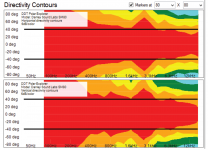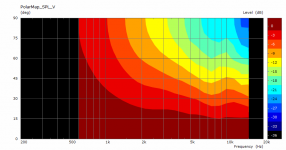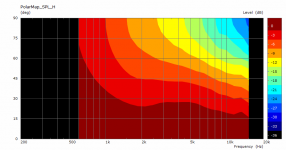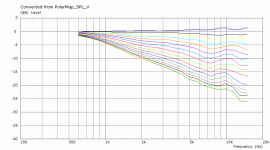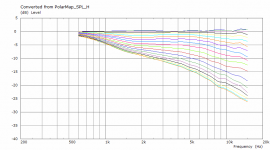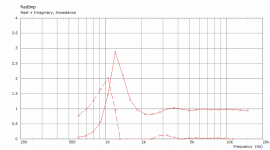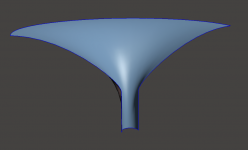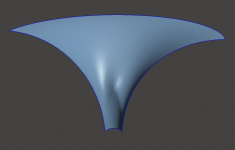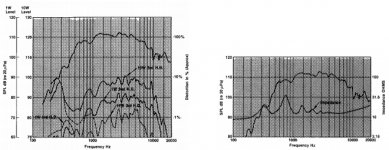???? even at 30 how is that not head in a vise...
sorry i thought that constant directivity is supposed to be about wider dispersion at higher frequency????
How did you fit "constant" into that thinking?
//
Controlled directivity comes before constant directivity, at least on my list.
The aforementioned horn won't provide a "typical" head in a vise experience, as directivity steadily increases with frequency and coverage is fairly constant across the mid range.
I'd prefer that horn to something like this:
The aforementioned horn won't provide a "typical" head in a vise experience, as directivity steadily increases with frequency and coverage is fairly constant across the mid range.
I'd prefer that horn to something like this:
Attachments
Last edited:
The nominal beam width is usually given at the -6dB
Thats interesting to know...When I said my sweet spot with current horn was the size of a basketball at 1 meter (~9.72" @ 16khz) I was judging by -3db to be exact.... For critical listening I wouldn't accept less (-6db) in order to call it a sweet spot.....but if we are going by the those standards....then I could say it was ~12.96" @ 16khz, -6db....
Thats about as accurate as I can get...its an elliptical tractrix that I cannot model...so I'd assume the beamwidth to widen slightly in that case.
I was looking at the article and thinking, I guess its already been done. I'm always trying to figure all angles...CTC specifically...its going to be hard to beat the horn I have or the jbl 2380a type of horn and keep my 400hz XO and CTC....I haven't taken any measurements with the Jbl horns but I'm surprised that the Strauss can pull it off....actually...I bet it doesn't really.
Making for a 60 degree wide beamwidth, hardly head in vice???? even at 30 how is that not head in a vise...
Last edited:
1" throat, 318 x 302 x 150 mm (could be made with a circular outline easily).
I have to say it's not totally bad and the throat acoustic impedance is considerably higher than usual.
Now I need to implement general 3D DI/radiated sound power calculations too see it better.
Also note that this is for an infinite baffle so the beamwidth is higher for lower frequencies than it would be in an enclosure or free standing.
I have to say it's not totally bad and the throat acoustic impedance is considerably higher than usual.
Now I need to implement general 3D DI/radiated sound power calculations too see it better.
Also note that this is for an infinite baffle so the beamwidth is higher for lower frequencies than it would be in an enclosure or free standing.
Attachments
Last edited:
Just remember that it will make the beam at the lower end wider than you thought too. At 400Hz it takes a pretty large device to have any real directivity so the woofer and horn can be crossed there as they are both pretty wide.
Its not narrow/wider than I thought...I subscribe to -3db not -6db....really should be -2db. My comment about my doubts of the Strauss crossing over stems from my own experience crossing the AXi over at 400hz with a 350hz (~330hz) tuned horn....Neglecting group delay....I simulated in horn resp, the highest tuning I could get to draw a straight line to 400hz with no issue (350hz)
The builder knew my goal and provided a slightly lower tuning than I paid for...combined with the Axi...AND I probably found the rare horn builder whos tunings are modest/honest (unlike AutoTech)....my measurements reach to 330hz before falling....
The thing that stopped me from going smaller at the time was the inability to take a steep roll off, like the average horn has past cutoff...and bending the curve straight to use it properly...its just not practical or possible though according to hornresp and my mock up of the Axi specs I had the Xmax for it...So looking at the measurements of the jbl horn....though the driver is different in the Strauss....a horn is a horn right?....and theres no way they bent that curve flat to 400hz....
its actually more feasible that they crossed the woofer over at 400hz but the Horn is crossed higher with a low order slope...I can't say I understand how much a compression driver can influence the cutoff...is there something there>?
Attachments
Last edited:
So...many..dots...and...thoughts...all...together 
Pick whatever value suits just make it the same across the frequency band. There is often an accepted standard and if you make up your own it can be difficult to communicate without confusion.Its not narrow/wider than I thought...I subscribe to -3db not -6db....really should be -2db.
There is not that that many dots! lol. You love picking on me, and I enjoy it as well...keeps me sharp...
I'm not trying to change everyone to go by -3db or -2db....unless they are designing Mastering Monitors...anything goes for the garage party...
"Pick whatever value suits just make it the same across the frequency band." - that is the epitome constant directivity...
I'm not trying to change everyone to go by -3db or -2db....unless they are designing Mastering Monitors...anything goes for the garage party...
"Pick whatever value suits just make it the same across the frequency band." - that is the epitome constant directivity...
So looking at the measurements of the jbl horn....though the driver is different in the Strauss....a horn is a horn right?....and theres no way they bent that curve flat to 400hz....
Why not?
1" throat, 318 x 302 x 150 mm (could be made with a circular outline easily).
I have to say it's not totally bad and the throat acoustic impedance is considerably higher than usual.
Now I need to implement general 3D DI/radiated sound power calculations too see it better.
Also note that this is for an infinite baffle so the beamwidth is higher for lower frequencies than it would be in an enclosure or free standing.
Looks good Mabat
Might be fun to print one and see if the measurements reveal somethings the simulations dont.
As my previous examples show it's possible to increase efficiency on the lower end by a resonance (by adding sort of a slot). I think this is also the case for the JBL M2 waveguide, for example. It's not completely clear to me what exactly resonates with what but perhaps such resonance could be employed as low in frequency as 500 Hz in some bigger device, I don't know.
Last edited:
I explained myself....the cutoff of the horn is too steep....take a look at that curve....look at the impedance...figure out a tuning.... model a horn tuned to that note in hornresp....I've already been down that road....you'll never bend the curve to play flat to 400hz....so, rather, I feel they may have ran the 15" to 400hz but the horn is likely cutoff higher orrrrr they really did place the crossover at 400hz...on the horn...and ran the woofer up higher to make up for the area in between 700hz and 400hz that the horn cannot carry....I forget about that trick....either way....I find it sceptical that that horn is crossed at 400hz....in the traditional sense, ie, the horn in the Strauss is very unlikely playing flat, 0db, down into into a 400hz XOWhy not?
Any comments on this TNT?
Last edited:
When speaking of crossovers, one should always consider the final acoustical reponses (i.e. with all the electrical filtering in the crossover). There's absolutely no reason why should be the horn flat by itself down to the crossover frequency (or even below).
Last edited:
Everyones talking but aint no one walking....
Group Delay? The want to not have to use an extreme amount of eq to achieve an acceptable Fr?
Instead of making comments I'd love to see a crossover at X where the cutoff of the horn+driver was actually 300hz above the X....since its not an issue I'm sure someone can easily demonstrate, we are talking horns...end result is a flat FR in combination with the woofer...and the horn plays Flat down to X, with the help of EQ I presume...
Wouldn't be the first time I was wrong.
There's absolutely no reason why should be the horn flat by itself down to the crossover frequency
Group Delay? The want to not have to use an extreme amount of eq to achieve an acceptable Fr?
Instead of making comments I'd love to see a crossover at X where the cutoff of the horn+driver was actually 300hz above the X....since its not an issue I'm sure someone can easily demonstrate, we are talking horns...end result is a flat FR in combination with the woofer...and the horn plays Flat down to X, with the help of EQ I presume...
Wouldn't be the first time I was wrong.
Last edited:
This group delay on the lower end of the passband of the device itself you often hear about is totally irrelevant. It is tied to the amplitude response of the device and the final group delay is given by the final acoustical response (and the crossover as a whole). I don't know who originated this notion but it's a complete nonsense.
Last edited:
- Home
- Loudspeakers
- Multi-Way
- Acoustic Horn Design – The Easy Way (Ath4)
